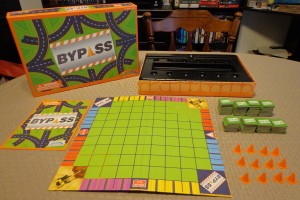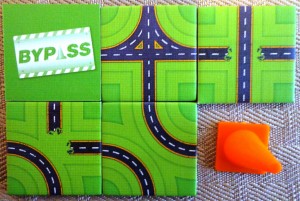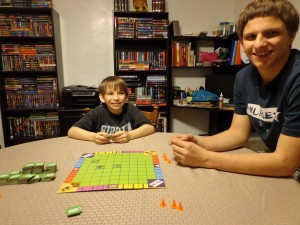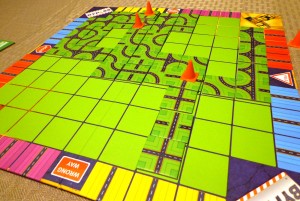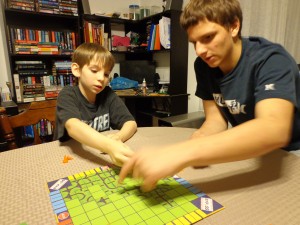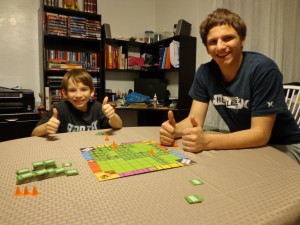“Bypass”, put simply, is a tile-laying game that tasks you with being the first person to connect roads from one side of the board to the other. Since everyone shares the same stretch of land and any roads that are placed, it becomes a challenge to complete your path and not help your opponents in the process. Before we take a look at the game in further detail, I’d like to thank Sue Jefferson from SimplyFun for sending me a free review copy.
Components
Board – The edges of the playing board are color-coded so that players can easily see what they need to connect in order to win the game. The rest of the playing surface is made up of squares large enough to fit the tile pieces.
Roadway Tiles – Players will be using these tiles to connect their colors located on either side of the board. The roads on the roadway tiles come in various shapes and forms…though all of the tiles cover the four cardinal directions. That is, all tiles can connect with each other and you won’t run into a situation where a tile can’t be placed.
Traffic Cones – Traffic cones allow players to keep particular tiles in play, making them immune to the “bypass” action…more on that in a bit.
Setup & Gameplay
The tiles are shuffled face down. Each player draws a tile and in clockwise order, places them on a space that doesn’t touch the colored roads or signs near the edges of the board. Each player then receives four tiles to form their hand and three traffic cones.
On a player’s turn, they’ll place one of the four tiles from their hand anywhere on the board. A player may “bypass”, or place a tile on top of an existing one, only if that tile is surrounded by other tiles in the four main cardinal directions. A player can place an orange cone on the tile they just placed, or give up placing a tile to put an orange cone on the tile of their choice. Orange cones lock in the tiles they are on and prevent another player from bypassing it. At the end of a player’s turn, they draw a new tile from the available pool.
The winner of the game is the first person to create a path from one side of the board to the other that links their designated color together. It’s important to remember that a player’s path must follow a straight line…that is, they can’t make ninety degree (right or left) turns at an intersection if one presents itself. They can however follow curved roads and on-ramps if they lead to another road.
The above is simply an overview of how the game is played, but it should still give you an idea of what the game is like. If you’d like to ask specific questions, please feel free to leave them in the comments below. There’s also a video tutorial available, located here:
The Review
Having recently reviewed “Word Bits” (also a SimplyFun product), I was excited to see how this game could be beneficial to kids even though it didn’t cover your basic subjects like math or vocabulary. I’m pleased to say that the game covers the subject of critical thinking well in that players must visualize their path and predict how their play might affect someone else. For those of you who haven’t read my article regarding critical thinking, it’s a skill that most kids should learn as early as possible for it teaches them the benefits of thinking ahead. If you’ve ever seen a couple of grandmasters play the game of Chess, you’d know that their minds are ten, even twenty moves ahead of the game’s actual state. “Bypass” helps kids to develop this skill in a similar way.
The components themselves functioned well. The tiles were varied enough to keep the game interesting, but not so crazy that one couldn’t come up with possible strategies as they played. The manual was an easy read and it didn’t take me long at all to teach the game to the kids.
The cones certainly added to the strategy element and were a nice addition to the game. If you foresee that your opponent(s) might have an easy time linking their paths, you can throw down a tile that will force their path to go off course and then lock it in with an orange cone. If you open yourself up to the possibilities (like the one described above), you will see that the orange cones can be used in an offensive way as well as defensively. They force players to not just think about how to get their path formed, but how they might be able to slow down their opponents in forming theirs.
By that token, the game we played was certainly a good mix of offense and defense. Vinnie (11) focused on keeping his path as straight and true as possible while Anthony (16) gave thought to how he might mess us up with some well-timed cone plays. Even without the cones, it was a battle of wits and what started out as a clear and concise set of paths turned into a jumbled mess of spaghetti that looked like it had fallen off of someone’s plate and onto the floor. As for myself, the game certainly tested my ability to think ahead and account for the different possibilities.
Overall, “Bypass” ranks up there with the tile-laying games that I have in my collection. Games like “Carcassonne” are fun to play, but can be confusing at times to those younger in age, especially with how their scoring mechanics work. “Bypass” is simple enough for players of all ages and can be played in a relatively short amount of time, making it an ideal choice for game nights that can’t last very long. If you are a fan of tile-laying games and have been looking for one that the little ones can play too, then “Bypass” fits the bill nicely.
Final Verdict: 8/10
—
You can learn more about “Bypass” by visiting the following website:
—

